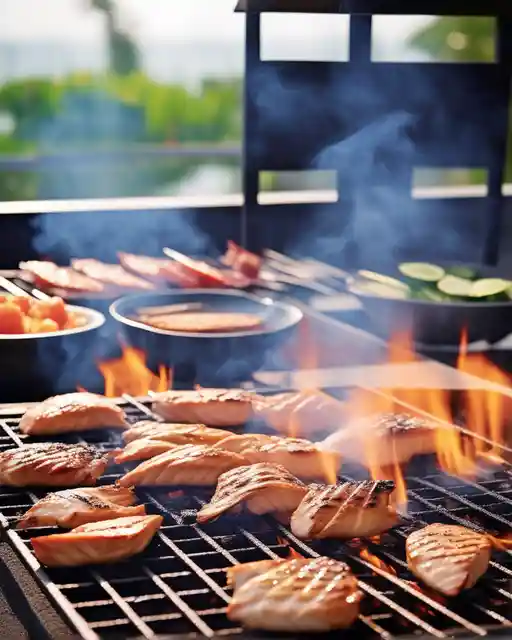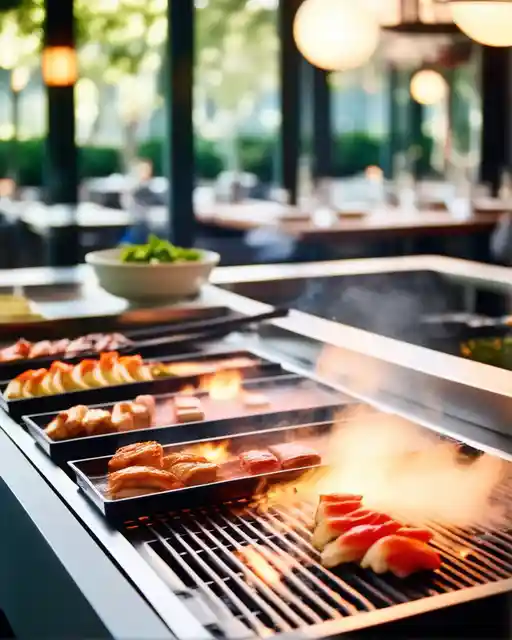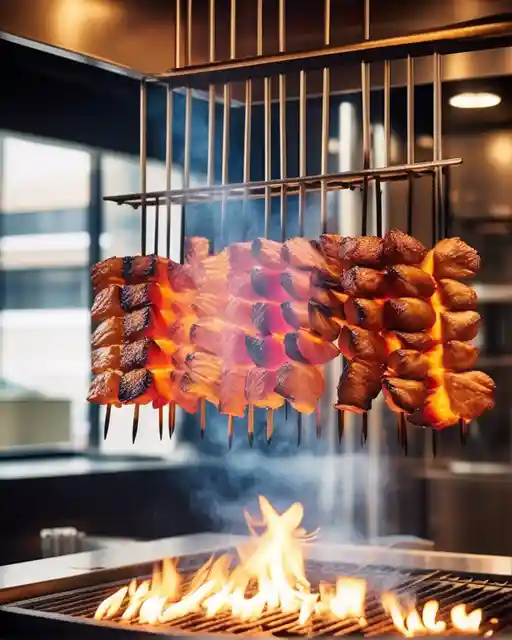Take Your Tastebuds To Tokyo With Japanese Grills
Updated: 03 Jul 2023
207

Cooking over an open flame is one of the oldest and most universal cooking methods known to humankind. But while we in the West typically think of throwing hot dogs and hamburgers on the barbecue, the Japanese have refined grilling into an art form.
From smoky yakitori chicken skewers to crispy gyoza dumplings kissed with char, Japanese grill cuisine offers an umami-rich indulgence for the senses. With a few simple tips and techniques, you can recreate the flavors of an izakaya right in your backyard.
So fire up your taste buds and get ready to experience the Japanese grill like never before!
History of Japanese Grill
Far before hibachis were hot, Japanese cooking already revolved around fire. Grilling traces back to 17th century Edo period Japan, when chefs skewered chicken, considered a luxury ingredient at the time, and cooked it over charcoal briquettes – sparking a delicious grilling tradition.
Later, sweet and sticky teriyaki sauce entered the scene, glazing meats and vegetables with its savory-meets-sweet flavor. After World War II, former soldiers opened small grilling food stalls called “yatai” to get back on their feet, popularizing this street food culture. From bustling cities to small towns, yakitori grilling took over Japan.
While keeping the tradition alive by grilling in the open air, Japanese chefs now put their creative spin on skewers. From smoky chicken to bacon-wrapped scallops, the possibilities are endless for Japanese-style grilling.
Grills Used in Japanese Cuisine
1. Traditional Charcoal Grill

- Simple design with charcoal bed below and grill rack above.
- It uses binchotan charcoal made from ubame oak to burn hot and clean.
- Imparts signature smoky flavor to food.
2. Teppanyaki Grill

- Flat metal surface for quick cooking.
- Cooks through direct contact rather than smoke.
- Tableside restaurants are used for hibachi entertainment.
3. Robata Grill

- Fires are fueled by binchotan charcoal or gas.
- Food skewers positioned above the heat on racks.
- Excellent for yakitori grilling and other skewers.
4. Konro Grill
- Barrel-shaped drum grill.
- Burn wood or charcoal in the bottom.
- Hang food above on hooks for smoking.
Regional Flavors Across Japan
- While yakitori grilling took hold across Japan, distinct regional grilling styles still emerged based on local ingredients and cooking methods.
- In Hokkaido, Japan’s northernmost island, fresh seafood like salmon and scallops are favorites on the grill. They’re often seasoned with garlic, butter, and soy sauce.
- In mountainous Takayama, chefs grill Hida beef, tender local beef known for its beautiful marbling. Hida beef steak is brushed with a light citrus soy or ponzu sauce.
- On the island of Okinawa, bitter melon and fresh pineapple shine on the grill, blending sweet and earthy flavors.
Whether it’s salty Hokkaido salmon or juicy Hida beef, Japanese grilling highlights local ingredients across regions.
Key Japanese Grilling Ingredients
1. Aroma and Flavor Boosters
- Splashing on extra flavors and scents makes foods tastier. Salty, sweet soy sauce, mirin rice wine, and sake add oomph when meats or produce marinate.
- Hearty miso paste from fermented beans and dashi seafood broth packs a hearty, meaty umami punch.
- Blending in these umami-rich ingredients naturally strengthens aroma and flavor.
- They help cuisine smell nicer and taste richer without extra salt, sugar, or fats.
2. Umami – The Fifth Taste
- Umami gives food a rich, savory, mouthwatering savoriness.
- Ingredients like dried seaweed and mushrooms have natural umami.
- Enhances the flavor of grilled meats and veggies.
3. Marinades and Rubs
- Homemade marinades and spice rubs bring key ingredients together.
- Impart tons of flavor before skewers even hit the grill.
Preparing a Japanese Grill
1. Firing Up the Charcoal
- Use the proper starter chimney to ignite charcoal.
- Let coals burn until covered in fine gray ash.
- Carefully distribute hot coals evenly on the grill.
2. Essential Grilling Tools
- Long cooking chopsticks for flipping and arranging.
- Flat metal skewers for making yakitori.
- Hinged wire racks to hold skewers over coals.
- Water pan or spray bottle for flare-ups.
3. Oiling the Grill
- Use cooking oil spray or oil-dipped paper towels.
- Apply a light coat of oil to grill grates.
- Helps prevent sticking and buildup of residue.
4. Maintaining the Heat
- Adjust air vents to control airflow and temperature.
- Move coals closer or further apart for direct/indirect heat.
- Add fresh charcoal gradually to replenish dying coals.
Following proper firing, arrangement, and oiling techniques will help you master the art of Japanese grilling. Having the right tools on hand will also make cooking a breeze.
Mastering Japanese Grilling Techniques
1. Grilling Differences from American BBQ
- Japanese grilling uses smaller, hotter fires instead of low and slow.
- Cooking times are faster – often just a few minutes per side.
- More focus on lighter, healthier prep with lean meats and veggies.
2. Binchotan Charcoal
- Made from ubame oak, this charcoal burns over 1,000°F.
- Burns steadily for a long time without sparks or flame flare-ups.
- Imparts signature smoky aroma and flavor.
3. Grill Accessories in Action
- Use tongs for safely flipping small items like shrimp.
- Long-cooking chopsticks prevent burning fingers.
- Wire racks suspend foods above direct heat.
- Use a water pan or spray to reduce heat instantly.
Following quintessential Japanese techniques like using proper binchotan charcoal and specialty tools will help elevate your grilling game. With a little practice, you’ll be dishing up a restaurant-quality Japanese grill in your backyard.
Popular Grilled Foods
1. Yakitori Chicken Skewers
- Small chicken pieces like skin, meat, and cartilage.
- Arranged on bamboo skewers in bite sizes.
- Basted with sweet and salty tare sauce.
2. Yaki Onigiri Grilled Rice Balls
- Formed balls of rice grilled until crispy.
- Flavored with soy sauce or nori seaweed.
- Portable, grab-and-go snack.
3. Grilled Fish and Seafood
- Fish like salmon, mackerel, and trout work well.
- Scallops, shrimp, and squid also shine on the grill.
- Brush with lemon, salt, pepper, or teriyaki.
4. Yakiniku Korean-inspired Grilled Meat
- Thin slices of fatty wagyu beef or kalbi short ribs.
- Quick cooking over high heat.
- Dip in spicy kimchi and sauces.
Feel free to also throw veggies like zucchini, eggplant, corn, and even fruits like pineapple onto the Japanese grill. The options are endless for fresh, flavorful fare!
Short Recipes
1. Yakitori Chicken Skewers

Ingredients:
- 12 oz chicken thighs, cut into 1-inch cubes
- 1⁄4 cup soy sauce
- 2 tbsp honey
- 1 tsp grated ginger
- 12 bamboo skewers, soaked in water
Instructions:
- In a bowl, mix soy sauce, honey, and ginger to make a marinade. Add chicken and let sit for 15 minutes.
- Thread chicken evenly onto skewers, leaving a small space between pieces.
- Grill over hot coals, turning frequently and basting with marinade, for 5-7 minutes until cooked through.
- Serve with extra marinade for dipping.
2. Grilled Soy Sauce Salmon

Ingredients:
- 4 salmon filets, 6 oz each
- 1⁄4 cup soy sauce
- 1 tbsp sesame oil
- 2 cloves garlic, minced
- Lime wedges for serving
Instructions:
- In a shallow dish, mix soy sauce, sesame oil, and garlic. Add salmon filets and turn to coat. Let marinate for 5 minutes.
- Grill salmon over hot coals for 3-4 minutes per side until opaque and flakes easily.
- Serve with a squeeze of fresh lime juice.
Tips for Grilling Like a Japanese Chef
1. Shop Smart
- Seek out authentic binchotan charcoal for high heat and aroma.
- Buy quality meats and produce – better ingredients mean better flavor.
2. Prep Properly
- Cut foods to a uniform size so they cook evenly.
- Marinate meats and veggies in sauces, spices, and aromatics.
- Soak bamboo skewers before using them to prevent burning.
3. Mind the Heat
- Sear foods over direct high heat to caramelize and seal in juices.
- Move to indirect heat to finish cooking gently.
- Keep a spray bottle on hand for controlling flare-ups.
4. Check Doneness
- Use a food thermometer to check meat is cooked to the proper temperature.
- Cut into fish, shrimp, and veggies to test for an opaque, moist interior.
5. Present with Pride
- Arrange colorful varieties of grilled foods on platters.
- Garnish with fresh herbs, lime wedges, and grated ginger.
- Serve with dipping sauces on the side.
With smart preparation, proper heating technique, doneness checking, and beautiful plating, your Japanese grilling skills will impress both eye and palate.
Serving Up Japanese Grill Deliciousness
1. For Sharing Family-Style
- Set up a build-your-own yakitori bar with arrays of grilled proteins, veggies, and sauces.
- Grill an assortment of seafood like salmon, shrimp, and scallops for a surf and turf plate.
- Offer yaki onigiri rice balls, pickles, and miso soup on the side.
2. For a Crowd
- Make teriyaki chicken or steak kabobs for a crowd at a backyard BBQ.
- Set up a teppanyaki station for tableside hibachi flair.
- Serve individual portions of donburi with grilled meat over rice.
3. For a Date Night In
- Impress your sweetheart with gourmet yakiniku Korean ribs and sides.
- Stuffed grilled peppers with flavorful fried rice for a simple light meal.
- End with sweet miso-grilled pineapple or peaches for dessert.
4. For Weekday Meal Prep
- Assemble ready-to-grab yakitori skewers in advance.
- Marinate steak cubes or chicken for quick grilling any night.
- Pack grilled rice balls and veggies for easy portable lunches.
With so many options, Japanese grilling makes both entertaining and everyday cooking a breeze.
Final Thoughts
From ancient times, Japanese cooks have elevated grilling over flames into an art form. Employing time-honored techniques like binchotan coal, zesty marinades, and trademark spices, you can recreate the smoky magic stateside.
Skewer up poultry, fish, or rice balls for hands-on, wholesome fun the whole crew will dig. Put your one-of-a-kind stamp on yakitori and teriyaki traditions. Firing up Japanese-style grilling makes fast, appetizing fare to unite your bunch and craft memories. Spark those briquettes and savor the flavor!
FAQs
What Do the Japanese Call Grills?
The Japanese name for grills is “yakimono”, which means grilled things. Another name is “robata”, referring to the traditional grill cuisine.
What is a Barbecue Called in Japan?
In Japan, barbecue is called “yakiniku”, meaning grilled meat. It comes from Korean barbecue and features thin sliced beef and pork.
What is a Japanese Charcoal Grill Called?
The traditional Japanese charcoal grill is called “robata”. It uses premium binchotan white charcoal that burns super hot.
How Would You Describe Japanese Grill Cooking?
Japanese grill cooking or “robata” features small skewers of meat, veggies, and seafood grilled over high-heat binchotan charcoal.
What is a Popular Korean Grill Used for BBQ?
A popular Korean grill used for barbeque is called “bulgogi”, made of thinly sliced marinated beef.
What are the three types of grilling?
The 3 main types of grilling are direct heat, indirect heat, and smoke grilling using hardwood chips or chunks.
Please Write Your Comments